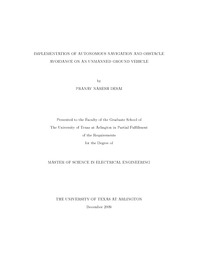
ATTENTION: The works hosted here are being migrated to a new repository that will consolidate resources, improve discoverability, and better show UTA's research impact on the global community. We will update authors as the migration progresses. Please see MavMatrix for more information.
Show simple item record
| dc.contributor.author | Desai, Pranav Naresh | en_US |
| dc.date.accessioned | 2010-07-19T19:54:21Z | |
| dc.date.available | 2010-07-19T19:54:21Z | |
| dc.date.issued | 2010-07-19 | |
| dc.date.submitted | January 2009 | en_US |
| dc.identifier.other | DISS-10437 | en_US |
| dc.identifier.uri | http://hdl.handle.net/10106/4855 | |
| dc.description.abstract | This thesis presents the implementation of a novel distributed embedded systems approach to real-time obstacle avoidance and guidance for an Unmanned Ground Vehicle (UGV). The mobility, real-time, and limited size requirements of UGVs, result in computationally limited and resource constrained hardware platform. The use of distributed computational resources, such as multiple embedded micro-controllers, enables the distribution of the computing resources for obstacle avoidance and guidance system functionalities. The resulting system's complexity is significantly greater than that of a single high performance processor performing all of the above functions. The hardware platform is integrated with sensors and micro-controllers to function as the real-time obstacle avoidance and guidance system for a UGV. The sensors include: a GPS receiver, a digital compass, rotary encoders, and a scanning laser range finder. All sensors have been calibrated and characterized for accuracy and reliability. The obstacle avoidance and guidance functionality executes on MPC555 micro-controller. The data strings from the sensors are parsed on IsoPod, PlugaPod micro-controllers. The required sensor data are passed over to the MPC555 over CAN network as part of a distributed computing architecture. A simulation model consisting of the guidance and navigation algorithm along with the tank model was developed. The simulation model performs obstacle avoidance and waypoint navigation successfully. A real-time model to perform obstacle avoidance and waypoint navigation was developed. The real-time model takes inputs as sensor data, constructs a dynamic map of the environment and outputs control signals to navigate the vehicle through obstacles and towards waypoints. The real-time system successfully performs waypoint navigation. The real-time systems constructs an inaccurate local map in real-time environment. An accurate local map is successfully constructed in simulation from the real world data. Due to the erroneous map constructed in real-time, the real-time system does not successfully navigate through the obstacles. | en_US |
| dc.description.sponsorship | Gibbs, R. Stephen | en_US |
| dc.language.iso | EN | en_US |
| dc.publisher | Electrical Engineering | en_US |
| dc.title | Implementation Of Autonomous Navigation And Obstacle Avoidance On An Unmanned Ground Vehicle | en_US |
| dc.type | M.S. | en_US |
| dc.contributor.committeeChair | Gibbs, R. Stephen | en_US |
| dc.degree.department | Electrical Engineering | en_US |
| dc.degree.discipline | Electrical Engineering | en_US |
| dc.degree.grantor | University of Texas at Arlington | en_US |
| dc.degree.level | masters | en_US |
| dc.degree.name | M.S. | en_US |
| dc.identifier.externalLink | https://www.uta.edu/ra/real/editprofile.php?onlyview=1&pid=270 | |
| dc.identifier.externalLinkDescription | Link to Research Profiles | |
Files in this item
- Name:
- Desai_uta_2502M_10437.pdf
- Size:
- 28.27Mb
- Format:
- PDF
This item appears in the following Collection(s)
Show simple item record


